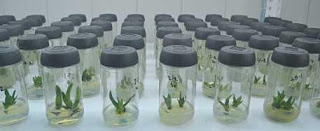What is Biotechnology?
Biotechnology is that the use of biological systems found in organisms or the utilization of the living organisms themselves to form technological advances and adapt those technologies to varied fields. These include applications in multiple fields, from agricultural practice to the medical sector. It doesn't only include applications in fields that involve the living but also the other field where the knowledge obtained from the biological aspect of an organism are often applied.
Mainly biotechnology
can divide to sub areas as medical biotechnology, agricultural biotechnology,
food and technology, marine biotechnology, environmental biotechnology and
industrial biotechnology.
Medical biotechnology is that the use
of living cells and other cell materials to raise the health of
humans. Primarily, it's used for locating cures also as
getting obviate and
preventing diseases. The science involved includes the utilization of those tools
for research to
seek out different or more efficient ways of maintaining
human health, understanding pathogens, and understanding human cell biology. Here,
the technique is
employed to supply pharmaceutical drugs also as
other chemicals to combat diseases. It involves the study of bacteria, plant
& animal cells, to first understand the way they function at a fundamental
level. It heavily involves the study of DNA (Deoxyribonucleic acid) to urge to understand the way to manipulate
the genetic makeup of cells to extend the assembly of beneficial characteristics that humans
might find useful, like the assembly of insulin.
Genetic engineering also can get as a
part of biotechnology and the term gene-splicing or genetic engineering initially mentioned various
techniques used for the modification or manipulation of organisms through the
processes of heredity and reproduction. As such, the term embraced both
artificial selection and every one the interventions of biomedical
techniques, among them AI, in vitro fertilization (e.g., “test-tube” babies),
cloning, and gene manipulation. within the latter a part of the
20th century, however, the term came to refer more specifically to methods
of recombinant
deoxyribonucleic acid technology (or gene cloning), during which DNA
molecules from two or more sources are combined either within cells or in vitro
and are then inserted into host organisms during which they're ready to propagate.
Not only that when describing about biotechnology Fluorescence in situ hybridization (FISH) is a laboratory technique for
detecting and locating a specific DNA sequence on a chromosome. Then blotting
technique is a method routinely used in molecular biology for detection of a
specific DNA sequence in DNA samples. As well as DNA microarray, PCR
techniques, vaccines, antibiotics are some famous and more valuable techniques.
Vaccines are chemicals that stimulate the
body’s system to raised fight
pathogens once they attack
the body. They achieve this by inserting attenuated (weakened) versions of the
disease into the body’s bloodstream. It causes the body to react as if it had been under fire from
the non-attenuated version of the disease. The body combats the weakened
pathogens and, through the method,
takes note of the cell structure of the pathogens and has some cells that
‘remember’ the disease and store away the knowledge within the body.
 |
| figure:4 |
An example of this is able to be the
fungus Bacillus thuringiensis genes being transferred to crops. The BT protein is that the desired characteristic scientist would really like the
plants to possess,
and for this reason, they identified the gene causing BT protein to precise within the fungus
and transferred it to corn.
In agriculture field genetically
modified organism (GMOs) is very famous one and that
enhance the diversity of applications and the economic viability of industrial
biotechnology. GMO widely used for increase the flavor, yield in fruits and
vegetables as well as there so many varieties nowadays in market.
Next one is industrial biotechnology. So, Industrial biotechnology is that the application of
biotechnology for industrial purposes that also include industrial
fermentation. Applying the techniques of recent biology, it
improves efficiency and reduces the multifaceted environmental impacts of commercial processes,
including paper and pulp, chemical manufacturing, and textile. It includes the practice
of using cells like microorganisms,
or components of cells like enzymes, to get products in sectors
that are industrially useful, like food and feed, chemicals, detergents, paper and
pulp, textiles, biofuels, and biogas.
It includes the practice of using cells
like microorganisms, or components of cells like enzymes, to urge products
in sectors that are industrially useful, like food and feed, chemicals,
detergents, paper and pulp, textiles, biofuels, and biogas.
Concluding there are four main areas in
biotechnology. Medical and molecular biotechnology, agricultural biotechnology,
industrial biotechnology and environmental biotechnology. As a Biotechnologist
you'll study the genetic, chemical and physical attributes of cells, tissues and
organisms so
as to develop new technologies, processes and products which will improve the standard of
human life.
REFERENCES
https://www.conserve-energy-future.com/biotechnology-types-examples-applications.php
https://www.prospects.ac.uk/job-profiles/biotechnologist
https://www.bio.org/what-biotechnology





Post a Comment